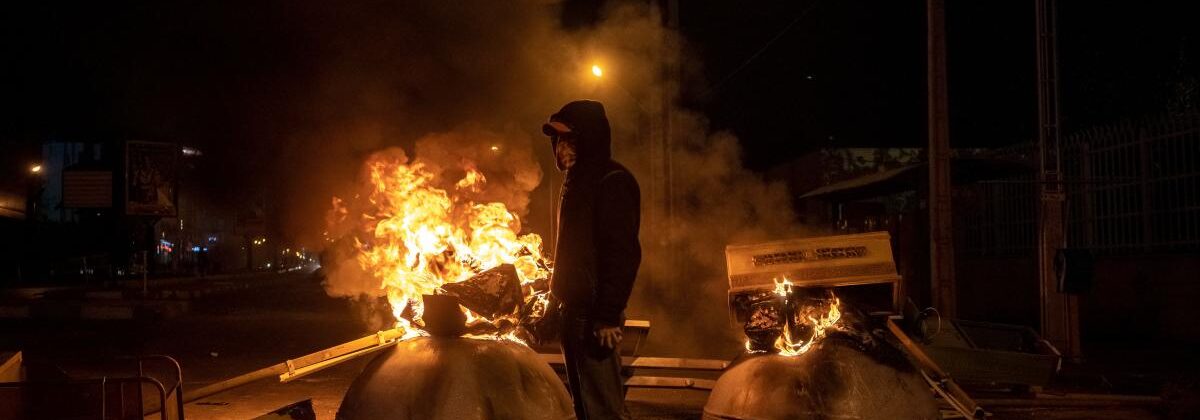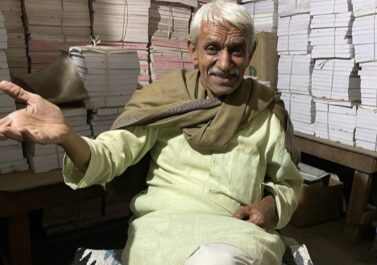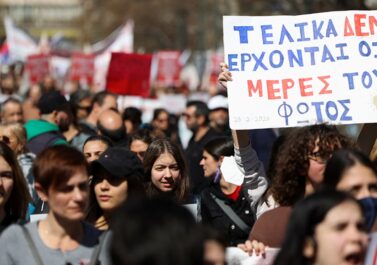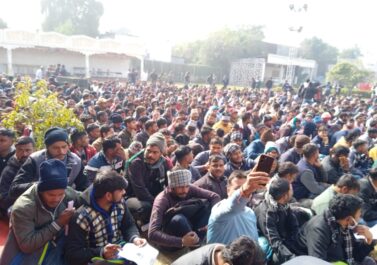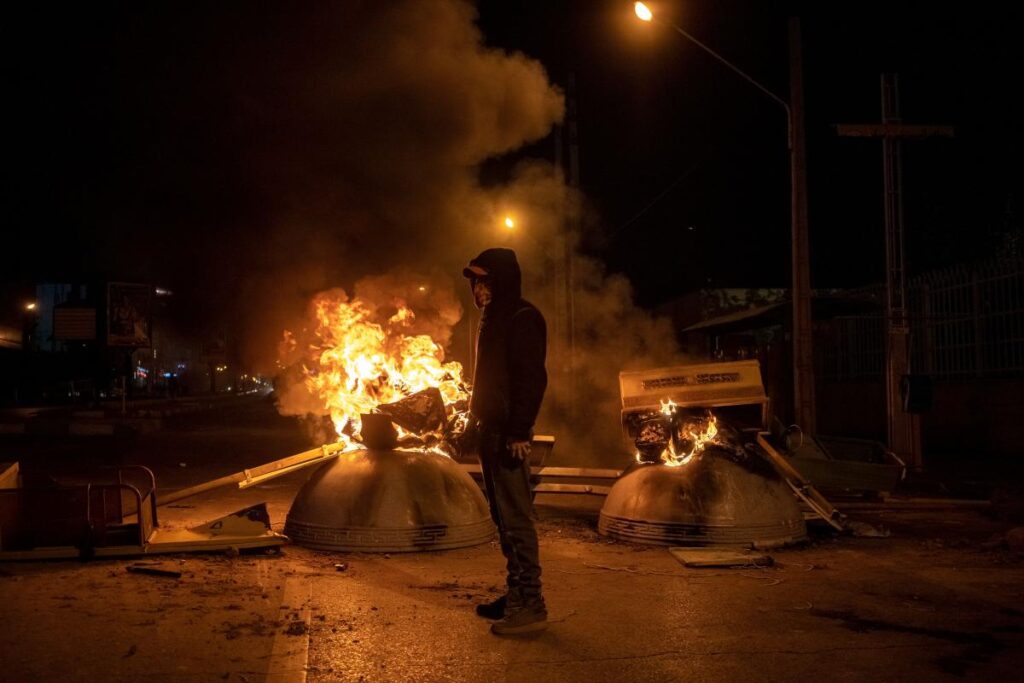
We document this text written by comrades from Germany, who have close relations to the situation in Iran. The situation is volatile, workers’ struggles merge with protests about various social issues. As the text below demonstrates, there is also a danger of movements ending up in regionalist dead-ends, given the uneven development within the wider region. Similar to the situation during the beginning of the uprising in Syria large parts on the left remain pretty silent when it comes to the class movements in Iran. A statist and crude anti-imperialism has stabbed the international working class in the back many times. The text was originally published here.
By: kollektiv from Bremen
Largely ignored by the mainstream media but also by the left-wing public, large-scale demonstrations have been taking place in several cities in southwest Iran for more than 14 days. The trigger for the mass protests was an acute (drinking) water shortage as a result of the catastrophic dam-building policy of the Iranian government and rolling blackouts in the region. As always, the government’s response to popular protests is extremely brutal. In the meantime, the military has been rampaging across the region, and more than nine demonstrators have been killed by the security forces while many others have been arrested.
The protests are mainly taking place near the Iraqi border, in the province of Khuzestan, the south of which is predominantly inhabited by the Arab minority. For decades, the Iranian government has carried out a targeted expulsion and impoverishment policies against the Arab minority, which does not get integrated into the nationalist state logic and continues to fight for its right to cultural self-determination. Because contrary to what the nationalist state narrative would lead one to believe, a large part of the population of Iran belongs to different ethnic minorities, such as Turks (in Azerbaijan etc.), Kurds, Lors, Arabs, Baluchis, Turkmen, and Afghans, to name a few. During the Iranian Revolution (1979), leftist movements in the region had a great influence. It should be remembered that during the last mass protests of Jan. 2018 and Nov. 2019, large demonstrations took place in many cities in Khuzestan.
For the regime, it is about unhindered access to and control over the oil and gas resources in the province, because about 90% of Iranian oil and gas production comes from Khuzestan and 8% of the world’s oil reserves are there. For the past 40 years, the Iranian regime has attempted to “Persianize” the province with a forced population exchange for changing the regional demography. More than 200,000 hectares of land were confiscated from small Arab farmers and transferred to Persian settlers. Jobs in the oil and gas industry, administration or the service sector are mostly reserved for the Persian population. The Arab population has been denied many basic rights, and the province has been in a military state of emergency for years.
Besides the oil and gas industry, there are hardly any other industries in the province, which was most affected by the Iraq-Iran war and which was largely destroyed. To this day, the destruction of the war can be clearly seen, and reconstruction is not in sight. The majority of the Arab population lives mainly from sustenance agriculture and animal breeding or precarious work at the borders of cities. The ecological conditions in the region are an important factor for them to survive.
Similar to the Turkish government, Iran has planned and implemented huge dam and river diversion projects in recent decades. According to the Resalat newspaper, a total of 170 dams were built on the Khuzestan rivers and their tributaries. According to government information, more than 150 dam construction and water diversion projects are still being planned, many of them on the rivers that flow through Khuzestan. The aim is to provide water for industries and agribusiness in other provinces, and to bring the country’s military and economic elite a lucrative business. Iran is now the second largest dam builder in the world after China. In addition to dams, numerous rivers have also been diverted from the nearby region to transport water to other Iranian provinces. The river diversions and dams not only flooded thousands of villages and displaced the residents, but also permanently destroyed the region’s natural ecosystem. Many of the rivers and lakes in the region have now dried up, many of the smallholders can no longer irrigate their fields adequately, and entire herds of animals have died of thirst. The dam and water policy leads to an artificially created drought and massively intensifies the effects of climate change in the region.
Against the background of decades of systematic discrimination/expulsion, state-produced poverty, as well as the water policies outlined above, an acute (drinking) water shortage and numerous power outages are the reason for the outbreak of current mass protests. For about 14 days, thousands of people have taken to the streets every evening in almost every town, village and municipality in the province. They not only demand concrete changes in their life situation, but also in many cases an end to the dictatorship. What is special this time is that both the workers in the oil and gas industry, who have themselves been on strike for more than five weeks, as well as the population in other regions of the country, including cities that are predominantly made up of the minority of the Lors, have joined and shown their solidarity to the uprising. In the past, the relationship between the Arab minority and Lors was marked by conflicts and disputes. The numerous expressions of solidarity on the part of the Lor population therefore represent a new quality for the protests. There have also been solidarity demonstrations in other large cities such as Tabriz, the capital of the province of Azerbaijan, and in Tehran, the capital city. The experience of the suppression of the mass protests in recent years, as well as the increasingly shared experience of poverty and precarious working conditions (as a result of neoliberal politics and the destruction of nature) have led to a new awareness within the population. An awareness that, despite all their differences, only a common fight against the regime can succeed. For the continuation of the current uprisings, the further development of the workers’ struggles also plays an important role. If the solidarity strikes expand and eventually lead to a general strike, this would be an important step in overcoming the long-term impasse of repression into which the mass protests have so far led.
The regime’s response to the protests always follows the usual pattern: denial, criminalization and massive repression. When the first videos of the demonstrations in Khuzestan surfaced, the regime claimed they were fake. When the protests became obvious, the regime admitted problems with the water and electricity supply, but accused the demonstrators of being manipulated or controlled by foreign powers and wanting to harm Iran by pursuing efforts to separate. At the same time, the military presence was massively expanded and the protesters were brutally attacked. As in the mass protests of 2018 and 2019, the protesters were shot at with live ammunition, many demonstrators were injured, some seriously, and several were killed. In order to prevent the spread of recordings of the protests on the Internet and to interrupt communication channels, the Internet and cellular networks were also switched off for days. Many demonstrators were also arrested inside hospitals that injured demonstrators were taken to for necessary treatment. During this time, instructions on how to operate on gunshot wounds and other such injuries began circulating on the Internet. The idea being that protesters would stay home instead of seeking hospital treatment as a way to avoid possible arrest. In the repression of its own population, the regime uses not only weapons but also the most modern surveillance technologies, which it receives from German companies, among others. For example, after the 2009 Green Movement, it became known that Siemens had supplied surveillance technology to Iran. Recently, participation in demonstrations has been traced using a new technology that is based on the analysis of electronic chips that are e.g. on EC cards.
The current protests in Khuzestan and in some neighboring provinces are part of a series of mass protests and waves of strikes that break out in Iran increasingly at ever-shorter intervals. In contrast to what the regime (and part of the anti-imperialist left) portray, they are not the result of foreign provocations, but the consequence of the regime’s decades of ultra-neoliberal policies and systematic discrimination, which have led to the impoverishment of large sections of the population in Iran. Unemployment and extremely precarious working conditions are the order of the day, active labor activists are brutally persecuted, arrested and tortured, as are participants in the mass protests. Since the regime’s only response is to brutally crackdown and suppress all resistance tendencies, the various crises in Iran will continue to escalate in the future and result in further mass protests. It is all the more important that the leftists in western countries take a clear position on the protests in Iran and show solidarity with them. First and foremost, this includes breaking the silence and giving the protesters and their struggles a public voice. At the same time, it is important to make visible and attack the role played by western politicians and companies in supporting the Iranian regime and its repressive apparatus.
In the mainstream media there is criticism mainly of the authoritarian and patriarchal aspects of the dictatorship in Iran. The catastrophic effects of neoliberal politics, as well as the numerous strikes and mass protests against it, are much less discussed. As far as the prevailing politics are concerned, this is not surprising. It is critical to notice, however, that even still in parts of the left movement there is no solidarity with the protesters – partly on the part of the Iranian left as well as the non-Iranian left worldwide. The reason for this is an odd understanding of imperialism that starts exclusively at the level of the states and divides them schematically into imperialist and anti-imperialist forces. Iran is then stylized as an anti-imperialist power against US imperialism and any protests within Iran are reduced to regime change efforts of the USA. This logic ultimately means that even parts of the Iranian left in the current situation support the Iranian regime and follow their justification that the crackdown on the mass protests is a necessary defense against US imperialism. The fact that Iran itself pursues an imperialist policy in the Middle East and brutally enforces and implements the prevailing conditions of capitalist exploitation against its own society remains less important in this reading, as does the inevitable resistance of the population to the unbearable everyday conditions.
We consider support for the Iranian regime and a de-solidarization/de-legitimization of the protests to be fatal, and the underlying understanding of imperialism to fall very short. The latter separates anti-imperialist struggles from anti-capitalist struggles and inevitably ends up in geopolitics and thus in the trap of nationalism. Even if the USA and other powers are trying to destabilize Iran from within, the mass protests of recent years cannot be reduced to this and their emancipatory potential cannot be denied. From our perspective, neither the bloody Iranian regime nor the bloody US intervention policy can be an alternative, rather only the potential of the oppressed, which is realized through their own movements; because the emergence of revolutionary subjectivity is a process of struggle from below. In this respect, the revolutionary character of an uprising should primarily be judged on the basis of its potential to change and influence people (i.e. awaking the class awareness), not on the basis of its direct effects on the structures of the established order. It is all the more important that the Iranian left in particular actively support the mass protests and uprisings and intervene in the related discourse in order to strengthen the emancipatory voices and forces within the uprising. The mass protests in Iraq from 2019 to the present have shown that many of the demonstrations against the Iraqi regime shouted the slogan “Neither Iran nor the USA”. These tendencies can also be found in the uprisings in Iran, because the experiences with the US interventions in Iraq and Afghanistan are also known to the people in Iran and strengthen positions that call for an emancipatory alternative.
The Middle East is in multiple crisis as a result of increasing militarization, the effects of climate change and the imperialist, neoliberal and nature-destroying policies of regional and global powers. Iran is considered a major player in the region. Growing protests and strikes in Iran are therefore also an important moment to inspire and encourage other people in the Middle East to stand up for their interests and to fight in solidarity for an alternative society.
Our solidarity is therefore with the demonstrators as well as the striking workers in Iran!
Let’s internationalize the fight!
Let’s internationalize hope!
* * *
